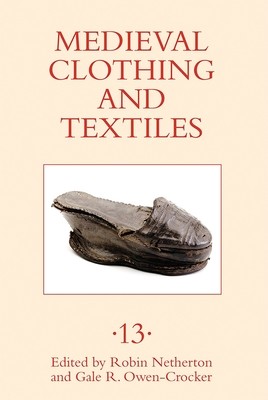
- We will send in 10–14 business days.
- Publisher: Boydell Press
- ISBN-10: 1783272155
- ISBN-13: 9781783272150
- Format: 15.5 x 23.9 x 1.5 cm, hardcover
- Language: English
- SAVE -10% with code: EXTRA
Medieval Clothing and Textiles 13 (e-book) (used book) | bookbook.eu
Reviews
Description
The best new research on medieval clothing and textiles, drawing from a range of disciplines.
Three of the essays in this collection focus on Italy, with contributions on footwear in Lucca based on documentary evidence of the fourteenth century; aristocratic furnishings as described in a royal letter of the fifteenth century, along with its first translation into English; and Boccaccio's treatment of disguise involving Christian/Islamic identity shifts in his Decameron. The Bayeux Tapestry is discussed as a narrative artwork that adopts various costumes for semiotic purposes. Another chapter considers surviving artefacts: a detailed study of a piece of quilted fabric armour, one of two such items surviving in Lübeck, Germany, reveals how it was made and suggests reasons for some of the unusual features. The volume also includes an investigation of the commercial vocabulary related to the medieval textile and fur industries: the terms used in Britain for measuring textile and fur are listed and discussed, especially the unique use of Anglo-French "launces" in a document of 1300. Contributors: Jane Bridgeman, Mark C. Chambers, Jessica Finley, Ana Grinberg, Christine Meek, Gale R. Owen-CrockerEXTRA 10 % discount with code: EXTRA
The promotion ends in 19d.14:42:08
The discount code is valid when purchasing from 10 €. Discounts do not stack.
- Publisher: Boydell Press
- ISBN-10: 1783272155
- ISBN-13: 9781783272150
- Format: 15.5 x 23.9 x 1.5 cm, hardcover
- Language: English English
The best new research on medieval clothing and textiles, drawing from a range of disciplines.
Three of the essays in this collection focus on Italy, with contributions on footwear in Lucca based on documentary evidence of the fourteenth century; aristocratic furnishings as described in a royal letter of the fifteenth century, along with its first translation into English; and Boccaccio's treatment of disguise involving Christian/Islamic identity shifts in his Decameron. The Bayeux Tapestry is discussed as a narrative artwork that adopts various costumes for semiotic purposes. Another chapter considers surviving artefacts: a detailed study of a piece of quilted fabric armour, one of two such items surviving in Lübeck, Germany, reveals how it was made and suggests reasons for some of the unusual features. The volume also includes an investigation of the commercial vocabulary related to the medieval textile and fur industries: the terms used in Britain for measuring textile and fur are listed and discussed, especially the unique use of Anglo-French "launces" in a document of 1300. Contributors: Jane Bridgeman, Mark C. Chambers, Jessica Finley, Ana Grinberg, Christine Meek, Gale R. Owen-Crocker

Reviews